Facebook reach: What it is and how to increase yours quickly

Table of Contents
The term “reach” often dominates conversations around Facebook marketing.
And rightfully so. After all, we want our posts to reach as many people as possible.
But this can be challenging when you’re up against competitors’ content, ads and even updates from friends and family.
That said, growing your reach on Facebook is possible. It’s equally important for brands to understand how reach analytics functions as a marketing KPI.
In this guide, we’ll break down the basics of Facebook reach, how to measure yours and increase it ASAP.
What is Facebook reach?
In short, your Facebook reach represents the number of unique users who see your post or page (regardless of whether they’ve engaged with it).
Let’s say you publish a post and 100 people look at it. Your reach is 100 people. Simple enough, right?
Facebook reach is measured within specific timeframes: daily, weekly, or 28-day periods. No overall reach metric exists. Instead, focus on these defined intervals to track performance trends.
Below is an example of weekly reach measured in the Meta Business Suite.
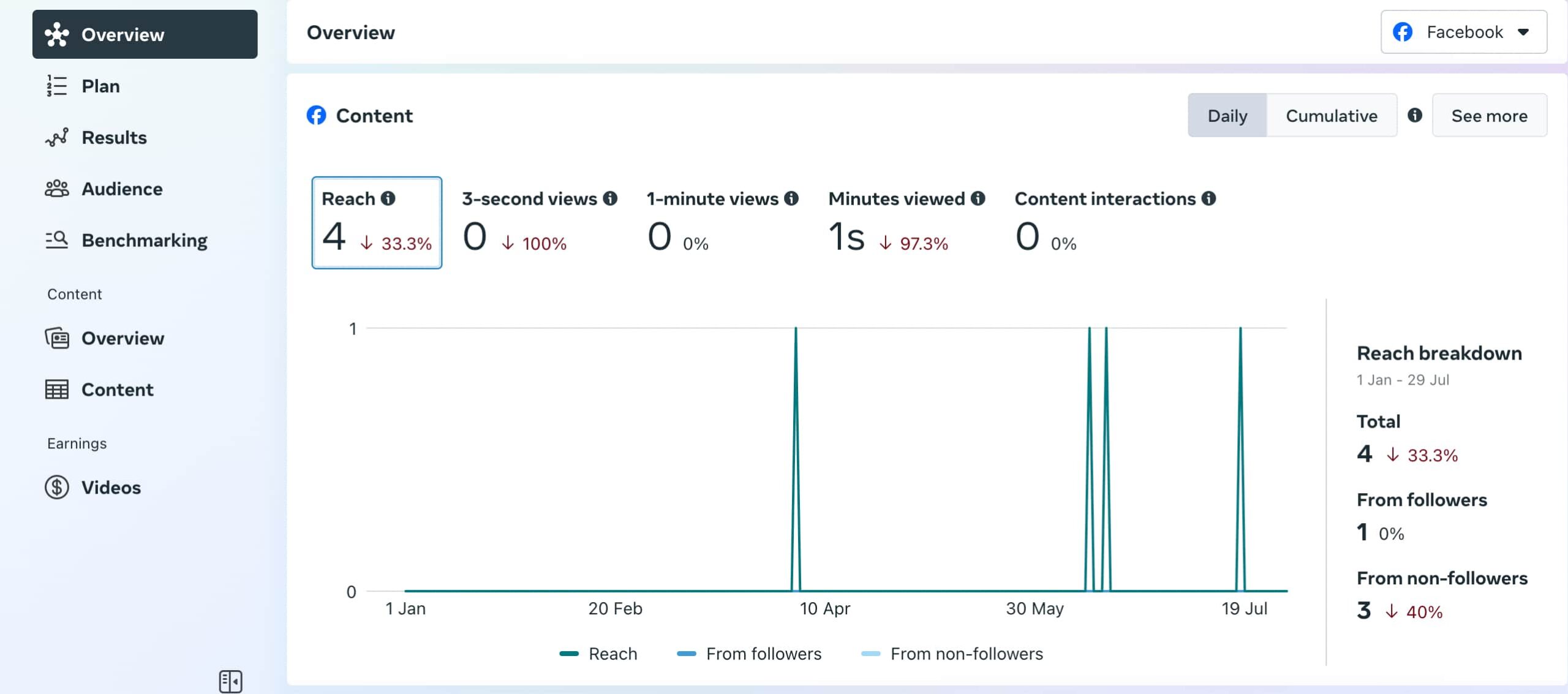
Obviously, Facebook has no way of tracking how many literal eyes see your posts while scrolling through their newsfeed. The platform simply tracks how many unique screens your post displays on.
Keep in mind that Facebook reach can be measured by post or Page. In short, if your Page’s reach is up that means more people are seeing your content (and vice versa). Meanwhile, individual posts will vary when it comes to their reach.
Why? Because reach is influenced by a number of factors much like the Facebook algorithm, including:
- Engagement and interactions from both followers and non-followers
- Content-type and optimization factors (video versus text posts, captions, timing and so on)
- Paid ads versus organic posts (the former has a reach determined by budget)
And yes, reach can vary wildly from post to post. This speaks to why marketers should track long-term trends with their Facebook reach.
Ready to take your social media strategy to the next level? See how Sprout Social can help you increase your Facebook reach and much more.
What are the different types of Facebook reach?
When looking to evaluate your own metrics, you’ll first need to distinguish between Facebook post reach and Facebook page reach.
This is where it can get a little bit confusing. Facebook post reach signifies the number of people who viewed a given post in their news feed. Meanwhile, page reach references the number of people who viewed any content during a specified time period. Determining which to focus on will largely depend on your Facebook content strategy.
Both Facebook post reach and page reach are divided into three categories:
Facebook organic reach
When most people talk about Facebook reach, they’re typically referring to organic.
Organic reach measures how many people saw one of your normal, non-sponsored posts.
This type of reach is the hardest to earn. You have to compete with paid ads, viral posts from major accounts and constant changes to the platform’s algorithm. As a result, many marketers note that organic reach has been falling for years now.
Facebook viral reach
Viral reach refers to how many people saw your content because someone else engaged with it via “Likes,” comments or shares.
This type of reach is based on interactions from other accounts, including followers and non-followers alike.
You’ve probably had content pop up in your newsfeed because someone else “Liked” it, right? That’s viral reach in action.
Facebook ad reach
Ad reach refers to the number of people who saw your Facebook ads at least once. According to Facebook themselves, the metric is estimated.
This type of reach is unique because it’s primarily based on budgeting and audience targeting. Ad reach is both a measure of how well your ads performed but also how well you managed to hone in our audience.
How does Facebook reach work?
Recent changes to the Facebook algorithm have been designed as an attempt to show users more of what they want to see. To determine where each post should be placed, Facebook began looking at:
- Meaningful interactions
- Replies
- Likes and comments
- Links shared on Messenger
These indicators are then factored into the order of posts and the way they’re presented to better ensure relevancy to users.
The difference between Facebook reach, impressions and engagement
The terms “reach,” “engagement” and “impressions” are often used interchangeably, but they measure different aspects of your content performance.
| Metric | What It Measures | Key Insight |
|---|---|---|
| Reach | Unique people who saw your content | Audience size and content visibility |
| Impressions | Total views including repeat views | Always higher than reach; shows content frequency |
| Engagement | Reactions, comments, shares, and clicks | Content resonance and audience interaction |
Ever wonder “What does ‘people reached’ on Facebook mean?” It means exactly that: the number of people whose eyes were in front of your content.
Marketers should measure all of the above. Facebook reach and impressions are obviously important. But you ideally want to boost your interactions alongside your reach. Doing so means exploring new ways to drive engagement. This will send signals to the Facebook algorithm to show your posts to as many people as possible.
Facebook reach benchmarks by industry
Facebook reach rates vary dramatically across industries. Understanding these benchmarks transforms meaningless numbers into strategic insights.
Here’s what successful reach rates look like across key industries:
- Retail & E-commerce: 2-5% organic reach rate with higher performance during promotional periods
- B2B Software: 1-3% organic reach rate with focus on quality over quantity
- Healthcare: 3-6% organic reach rate due to highly engaged, niche audiences
- Financial Services: 1-2% organic reach rate with strict compliance considerations
- Food & Beverage: 4-7% organic reach rate leveraging visual content strength
Your performance against these benchmarks reveals whether your content strategy works. Stop chasing universal averages. Measure against your industry peers and set realistic growth targets.
6 proven tactics to boost your Facebook reach
Despite popular belief, greater reach on Facebook isn’t totally in the hands of the algorithm. You can strategically plan your posts to ensure that they’re getting the exposure they deserve. This involves following key Facebook best practices to time and optimize your posts.
Here are a few tips on how to reach more people on Facebook:
1. Optimize your content formatting and captions for Facebook
This is especially important as cross-posting across Instagram or X (formerly Twitter) has become more and more common.
Simply put, you can’t treat Facebook as a dumping ground for content meant for other platforms. Specifically, make a point to:
- Craft unique captions (think: don’t include needless hashtags or use the exact same captions)
- Avoid posting only external links: focus on formats that keep people on Facebook (videos, infographics and so on)
- Consider including a call-to-action (“comment below”) or question to drive discussions
These tips are crucial for Facebook organic reach and getting more love from the platform’s algorithm.
2. Schedule your posts for the sake of consistency
It’s no surprise that many of the most engaged-with accounts on Facebook post on a daily (or near-daily) basis.
That’s because consistency matters for the sake of growing your presence and letting the algorithm know that you’re active.
Apps like Sprout Social allow you to queue up content to ensure you’re regularly publishing fresh posts. You can also use the native Meta Business Suite to schedule your posts and reach more people on Facebook.
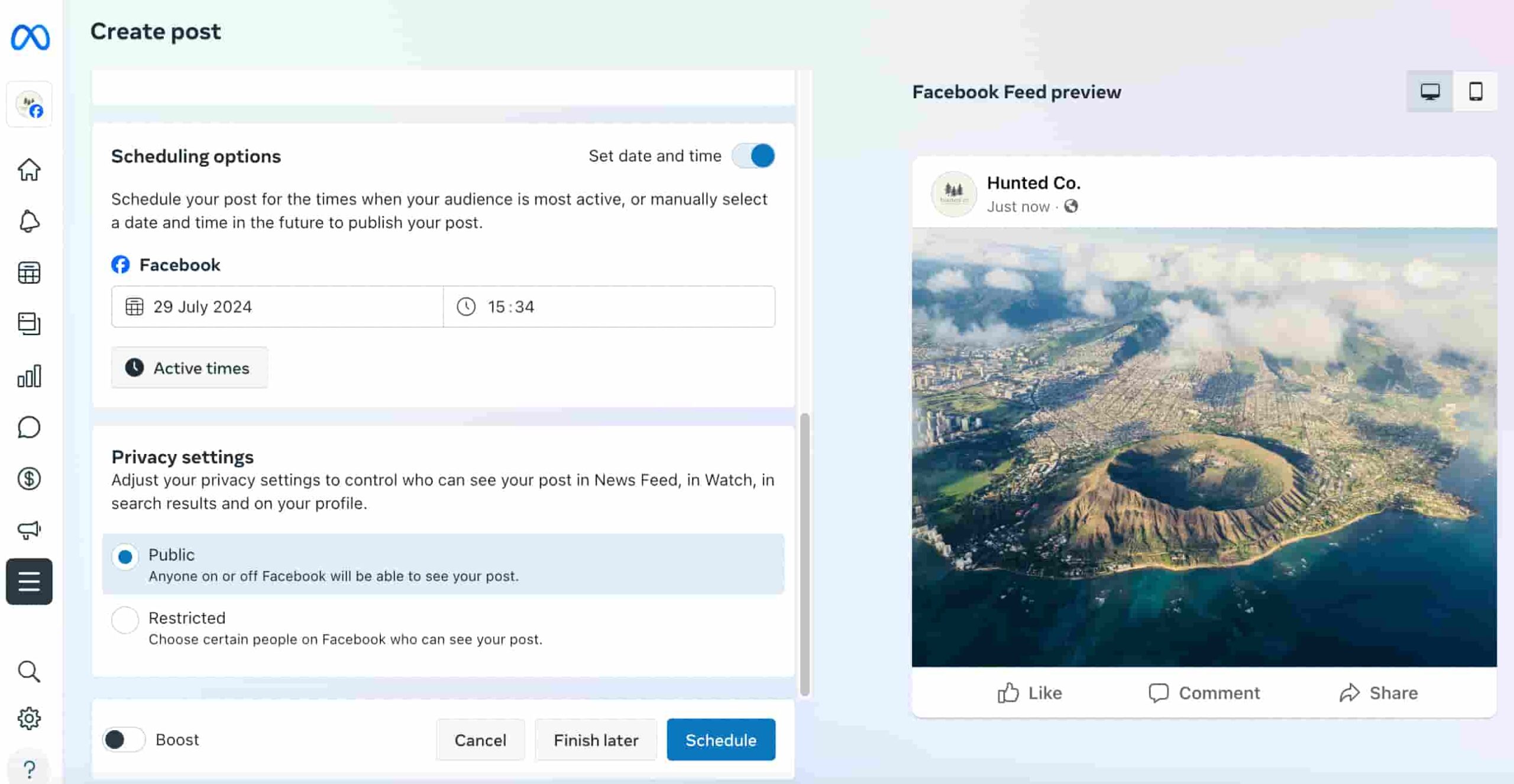
3. Time your posts to perfection
We’ve seen firsthand from researching the best times to post on social media how post timing and engagement correlate. Higher engagement, in turn, boosts your post visibility and reach.
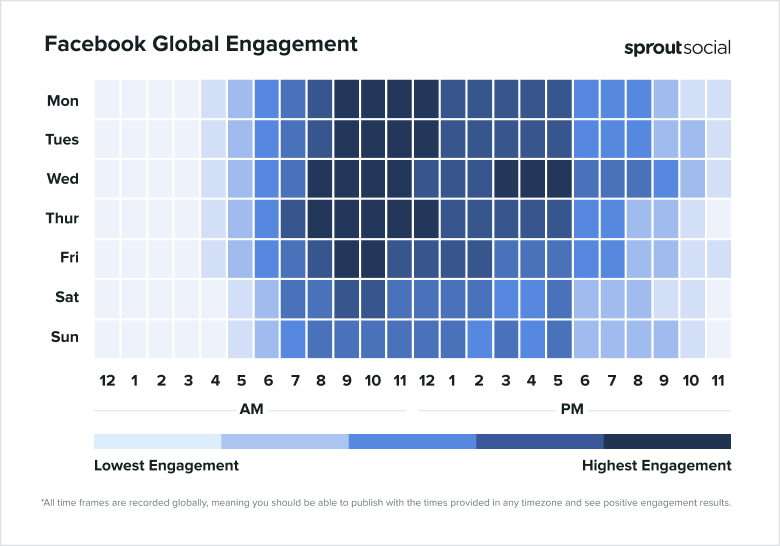
Optimizing your content timing isn’t the be-all, end-all of engagement. But it does increase the likelihood that your post reaches people when they’re most likely to see and engage with it.
Given how fierce competition is for organic reach, anything you can do to increase your content’s visibility is a plus. Using tools such as Sprout’s ViralPost, you can fine-tune your publishing times based on when your unique audience is most engaged.

4. Use videos and Facebook Live to encourage engagement
Facebook has been pretty explicit in recent years about how well videos perform.
Whether it’s a Live session or bite-sized promotion, integrating video into your content strategy is a smart move regardless of whether you’re concerned about Facebook reach. Note that many posts that earn viral reach via “Likes” and shares are often videos.
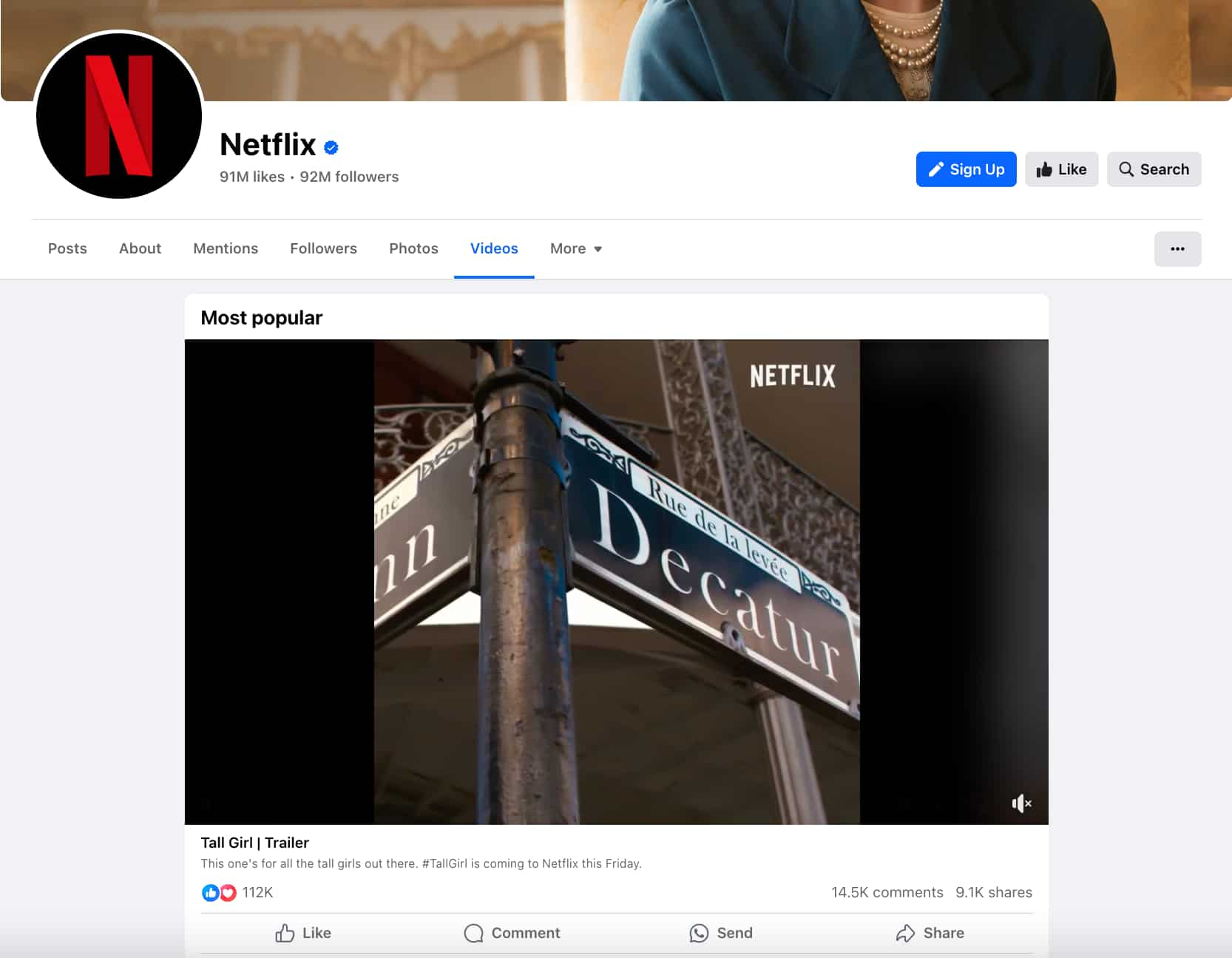
Source: Facebook
5. Get in front of fresh followers with Facebook ads
Depending on your business or industry, paying for reach via ads is a matter of “when” and not “if.”
The fall of organic reach has resulted in a direct rise in Facebook ads. While your potential reach is largely based on your bidding strategy and targeting, ads do represent a direct way to get your audience’s attention.
And for many brands, the investment is absolutely worth it.
Take PatPat, for instance, which saw a 13-point lift in brand awareness after running a Facebook ad campaign.
6. Use Groups and third-party engagement to increase visibility
Supplementing your page with activity engagement from Facebook Groups or individual accounts (think: employees or partners) is yet another way to earn viral reach.
Consider that any given account or Page is limited in terms of who can see any given post. Engagements from outsiders, however, can create a snowball effect where content is recommended to non-followers again and again.
How to measure your Facebook reach effectively
As noted earlier, Facebook reach can be assessed Page-wide or on a per-post level.
Track long-term reach trends, not daily fluctuations. Content outliers exist, but weekly or monthly patterns reveal your strategy’s true performance.
The good news is that you have plenty of options for monitoring your reach. For starters, the Insights tab in your Meta Business Suite gives you an overview of your account reach.
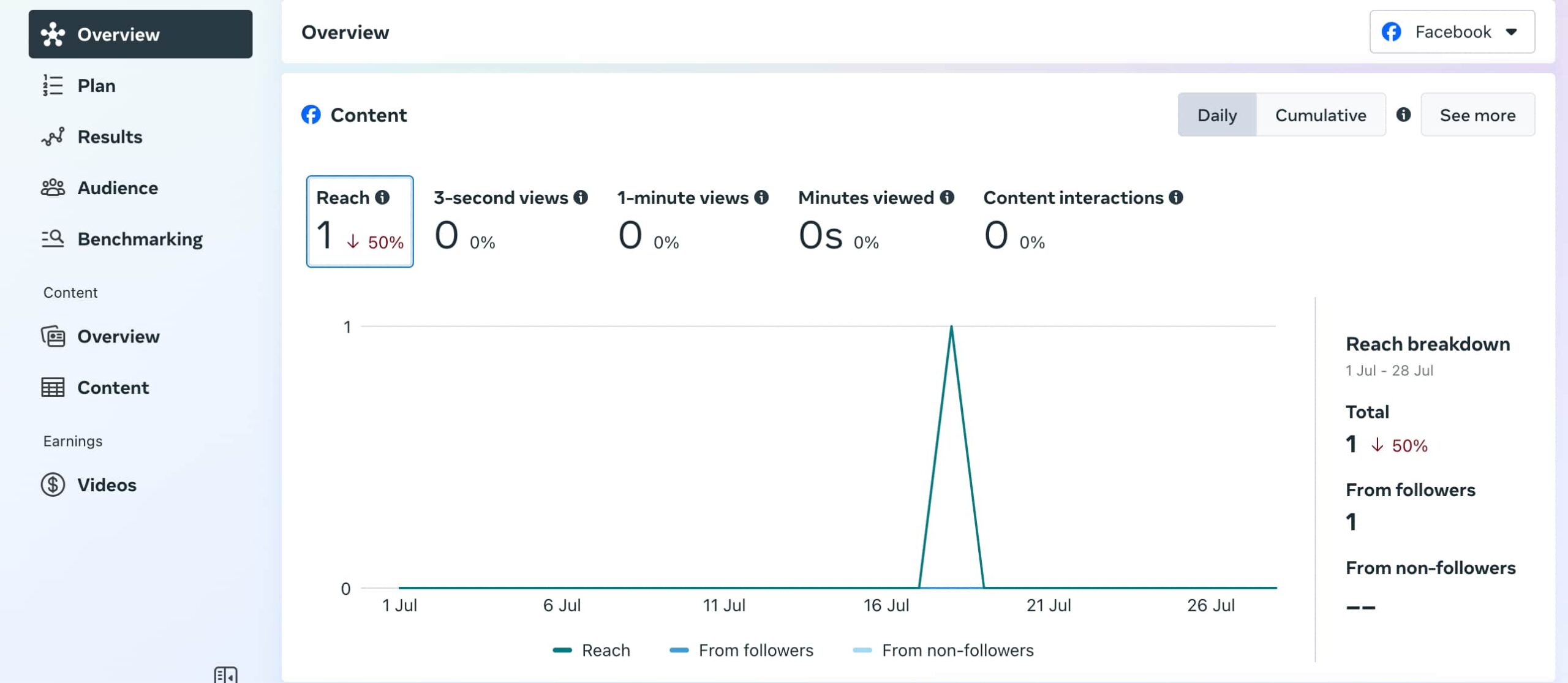
You can also go to the Content Overview tab to see how your content is performing in terms of reach and engagements. This tab makes it easy to compare the median reach for each media type and content format. So you can see which types of posts will get you the most reach. For example, videos may reach more people than image posts while Reels may reach more people than Album posts.
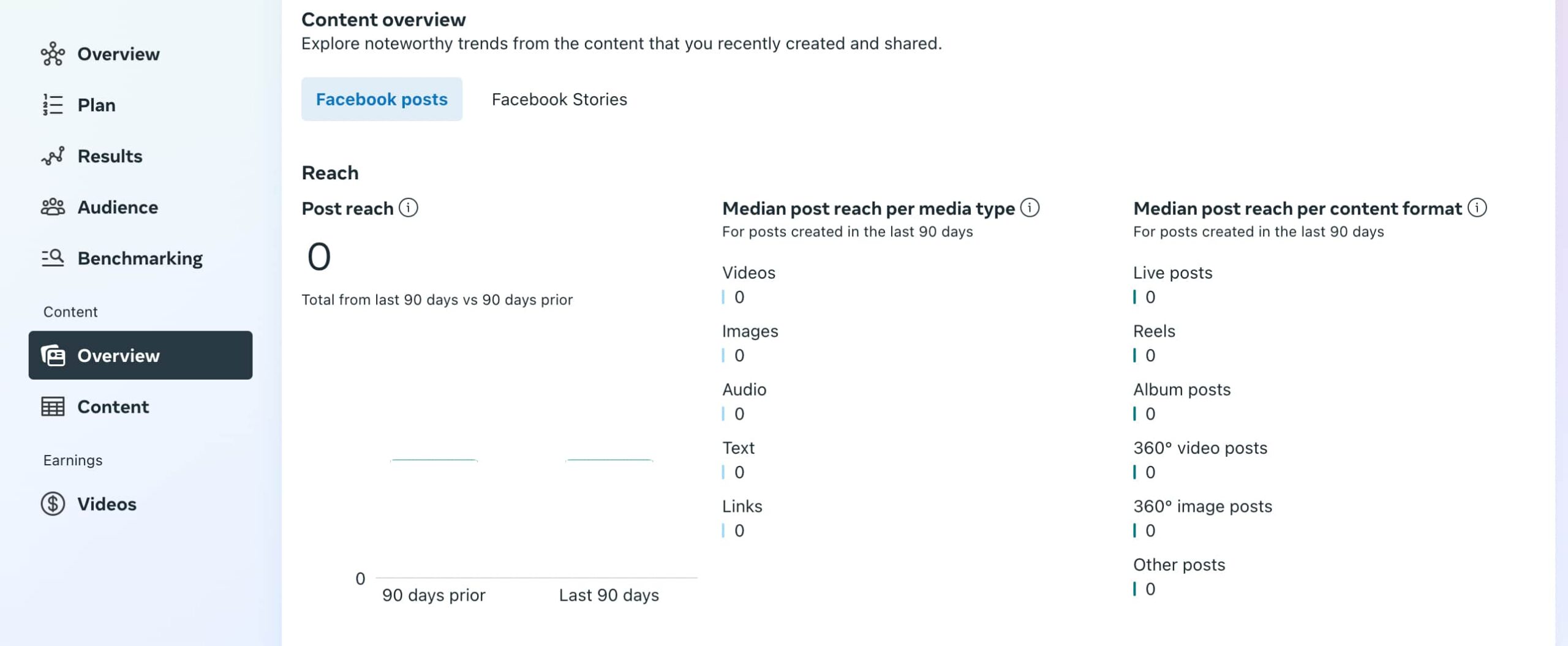
Further, go to the Content tab to access performance insights at the post level. This shows you how specific posts are generating reach and engagements. Click on any of the posts you want to analyze, and you’ll get an expanded view of its reach, impressions and interactions.
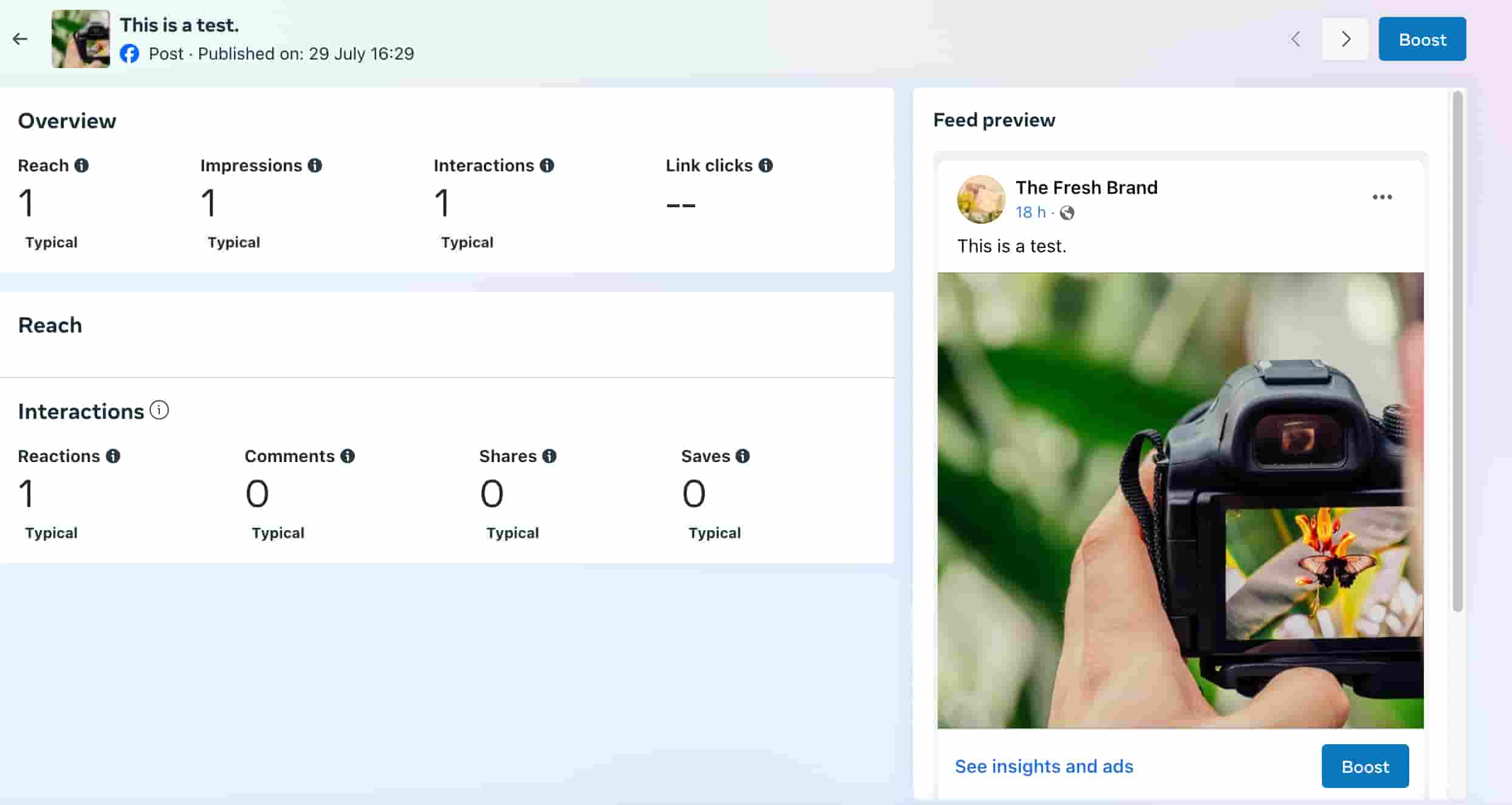
But again, it’s important to monitor trends and takeaways rather than obsess over individual numbers. For example, think about questions such as:
- Is my Facebook reach growing or going down? Why?
- How does my organic reach compare to my paid reach?
- Which individual pieces of content earn the most reach? Is there a connection between them (think: format, length, timing)?
Identifying the common threads between your top-performing posts is a must-do for marketers. With a platform like Sprout, you can easily monitor your impressions and reach over time. This will help you identify how you’re trending and whether changes to your content strategy are moving the needle.
Advanced Facebook reach measurement with social media tools
Facebook’s native analytics provide basic reach data. Advanced social media platforms like Sprout Social deliver comprehensive insights that drive strategic decisions.
Here’s what advanced reach measurement unlocks:
- Cross-platform comparison: Track reach performance across Facebook, Instagram, LinkedIn, and other networks in one dashboard
- Historical trend analysis: Access extended data retention beyond Facebook’s limited timeframes
- Content performance tagging: Identify which post types, topics, and formats generate the highest reach
- Team collaboration: Share reach insights across marketing, customer care, and executive teams
- Automated reporting: Schedule reach reports that connect social performance to business objectives
This depth of analysis transforms reach from a vanity metric into a strategic business driver. Native tools show what happened, while advanced platforms reveal why and what to do next.
How are you growing your Facebook reach?
Getting more Facebook reach doesn’t have to be an uphill battle.
That said, it’s important to understand how reach operates as a metric and what you can do to increase yours over time. Use these breakdowns and pointers as a starting point for grabbing the attention of your target audience and keeping it long-term.
And if you haven’t already, snag a trial of Sprout Social to more closely monitor your Facebook reach and uncover new opportunities to grow it.
Facebook reach FAQs
What is a good Facebook reach rate?
Good reach rates vary by industry: retail sees 2-5%, B2B software 1-3%, and food brands 4-7%. Focus on consistent growth rather than static percentages.
What is the difference between reach and impressions?
Reach and impressions are two fundamental metrics for measuring content performance, but they represent different things.
Reach: Accurately defined as the number of unique people who see a post or Page.
Impressions: Correctly identified as the total number of times content is displayed, which will always be equal to or higher than reach.
How do you calculate Facebook reach rate?
Reach rate = (Reach ÷ Total Followers) × 100. Apply this formula to individual posts or page-wide performance over specific periods.
What is a good Facebook reach rate?
A good organic reach rate is generally considered to be around 5.5% of your total followers, although this can vary significantly by industry and Page size. It is important to compare your reach to your own past performance and your specific goals rather than a universal benchmark.

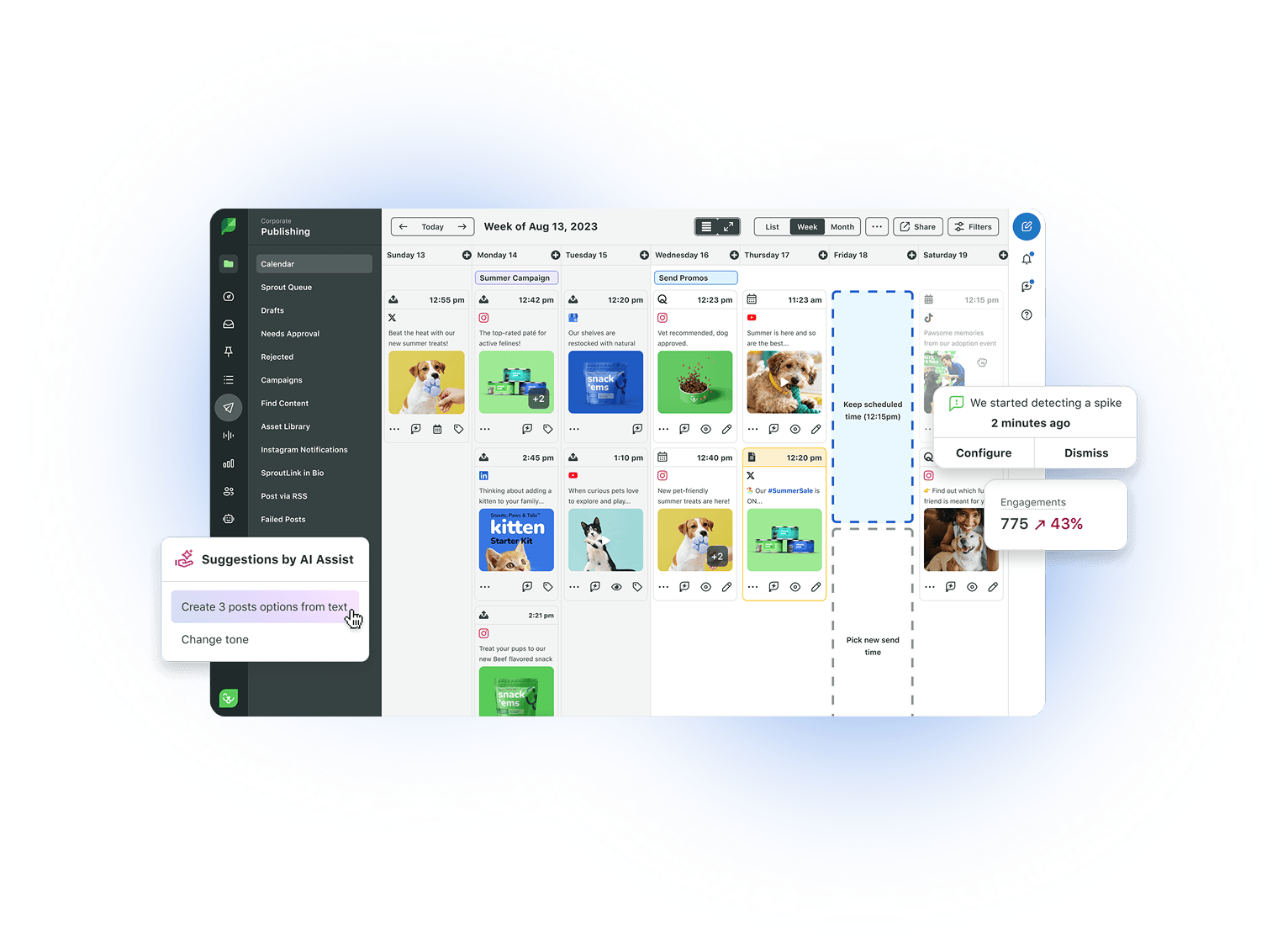
Share